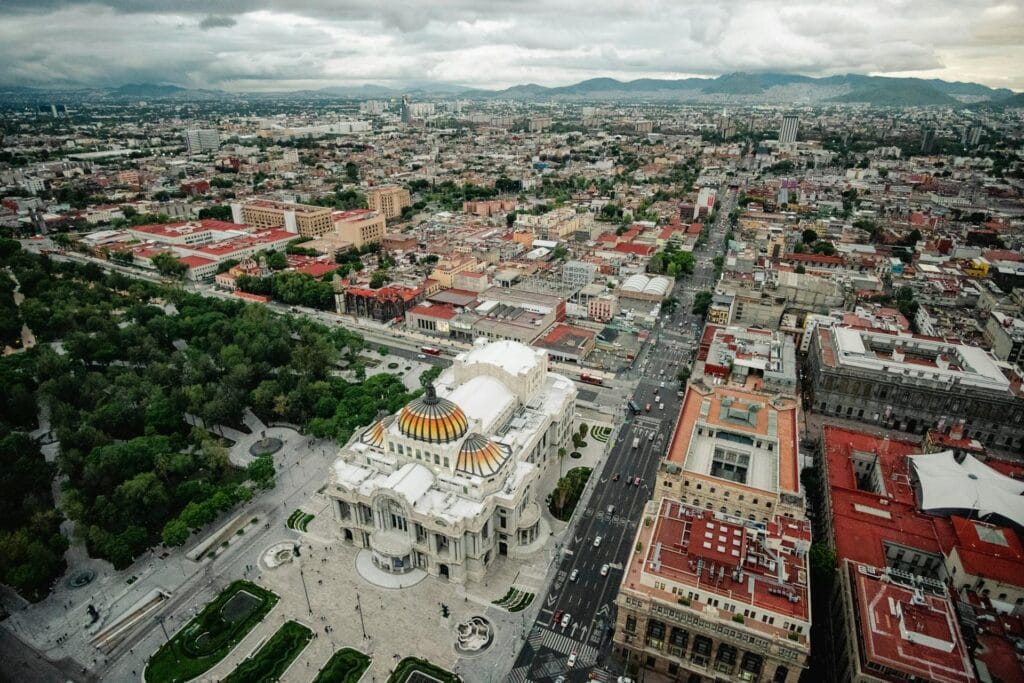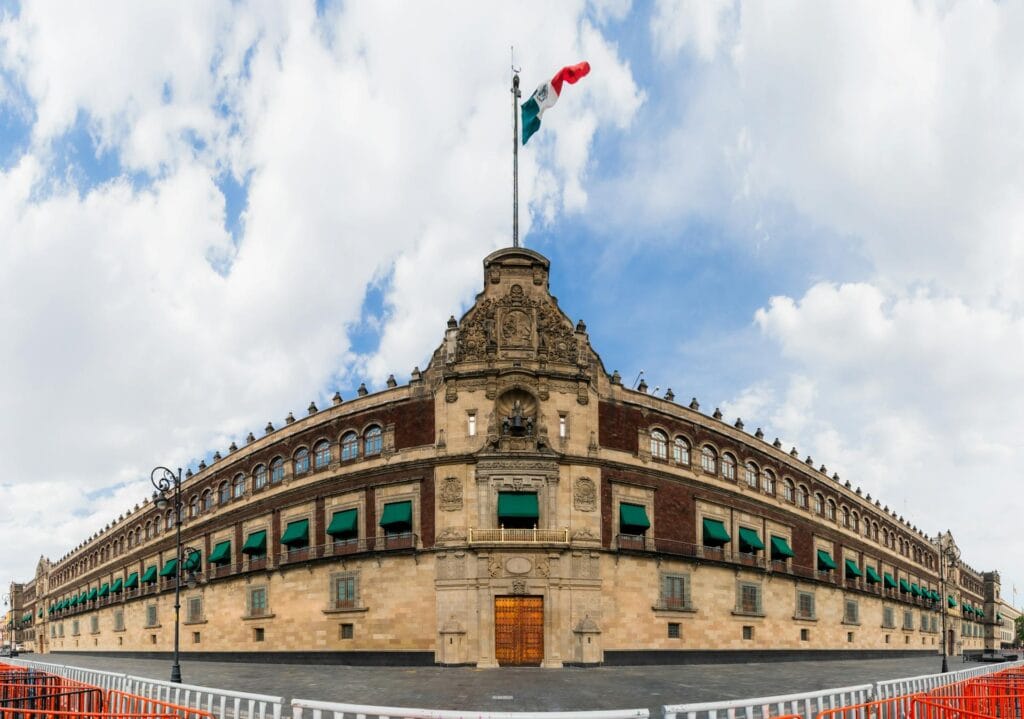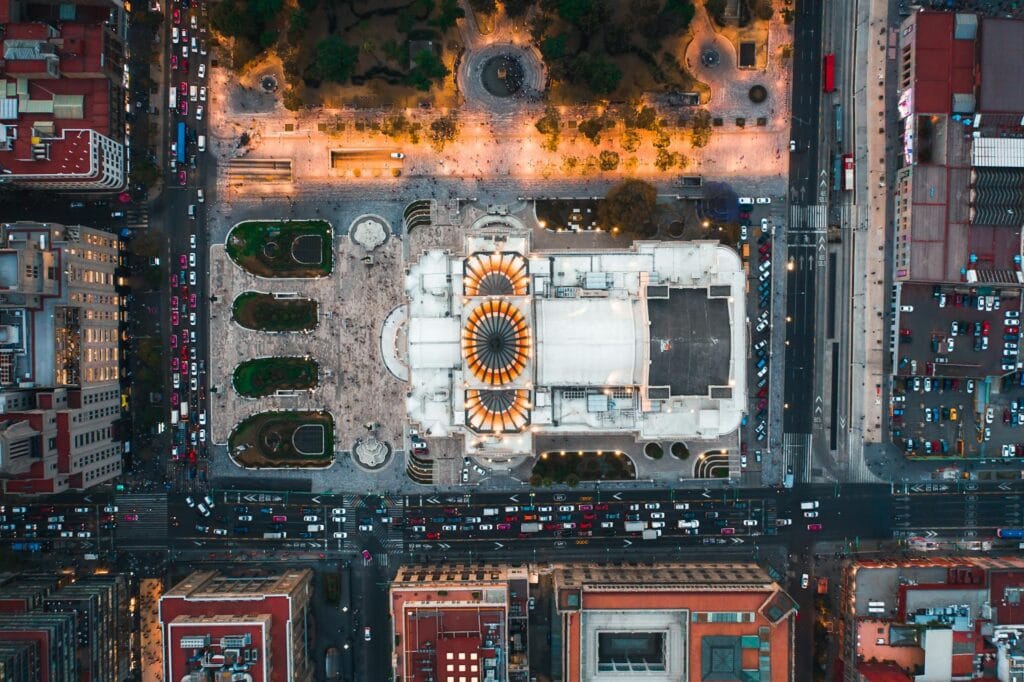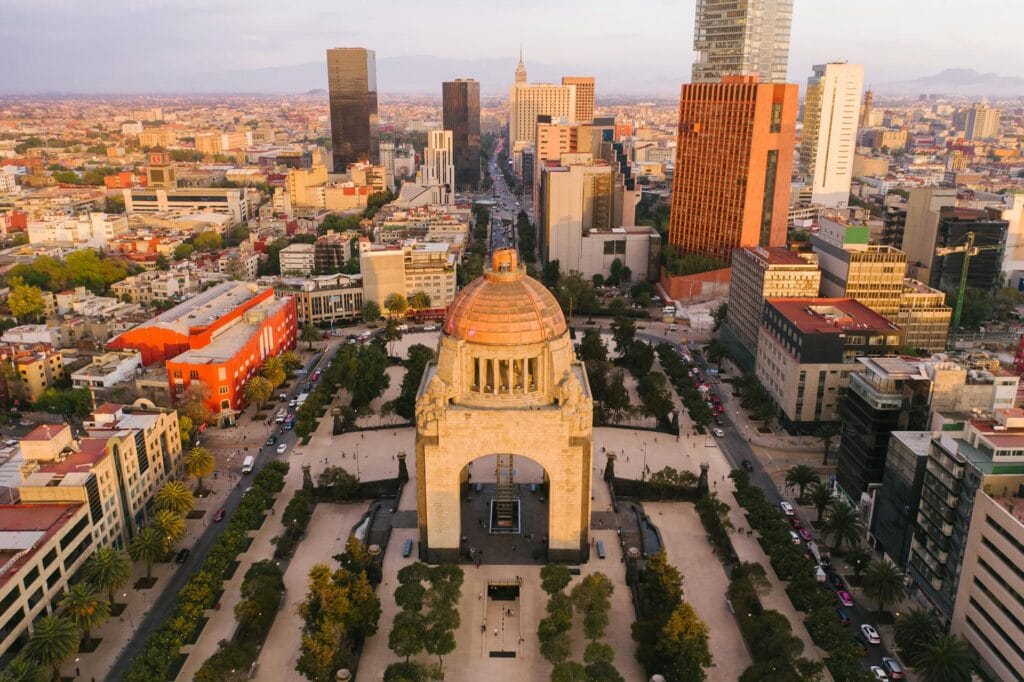Historic Center of Mexico City
The Historic Center of Mexico City, often called the “Centro Histórico,” is a lively area full of history, culture, and impressive architecture. It’s located in one of the oldest cities in the Americas, where people have lived continuously for hundreds of years. Acknowledged as UNESCO World Heritage Site, this neighborhood showcases a fascinating mix of ancient Aztec ruins, beautiful colonial buildings from the Spanish era, and the bustling life of a modern city.
As you walk through the lively streets, you’ll see famous sites like the impressive Metropolitan Cathedral, the beautiful Palacio de Bellas Artes, and the ancient ruins of the Templo Mayor. These landmarks tell the story of the city’s fascinating history.
The Historic Center is a key part of Mexico’s rich history and is also a vibrant place full of life. It has many museums, art galleries, shops, and restaurants, making it an excellent spot to explore for anyone visiting the lively capital.
Table of Contents
Where is the location of the Historic Center of Mexico?

The Historic Center of Mexico is located in the heart of Mexico City. It’s surrounded by several main streets: Avenida Juárez on the north, Avenida 16 de Septiembre on the east, and Eje Central Lázaro Cárdenas on the west and south. This area is filled with history and has many famous sites, like the Zócalo, which is the main square, the Metropolitan Cathedral, and the Templo Mayor. It serves as an important cultural center for the city.
Inscription
The Historic Center of Mexico City was acknowledged as a UNESCO Heritage Site in 1987 because of its incredible cultural and historical importance. This area highlights Mexico’s rich heritage and acts as a living example of how urban planning and architecture have evolved over many centuries. It’s a place where you can see the story of the city unfold through its buildings and streets.
Recognizing a UNESCO World Heritage Site highlights the importance of protecting this valuable heritage. It also inspires both visitors and locals to acknowledge and enjoy the cultural significance of the Historic Center. This area represents Mexico’s identity, history, and its growth as a vibrant city in the Americas.
What is the History of Mexico City?

Mexico City, the capital of New Spain, is known as the “city of palaces.” It was established in the 16th century by the Spanish on the site of Tenochtitlan, the ancient capital of the Aztecs. In this Mexico City area, you can find five Aztec temples that have been uncovered, along with a stunning cathedral, which is the biggest in all of North America. Additionally, there are many beautiful public buildings from the 19th and 20th centuries, including the well-known Palacio de las Bellas Artes.
This city was designed based on European styles but was also shaped by the skills of local indigenous artisans and workers. Additionally, the city incorporated the canals and rivers that were important in the design of the Pre-Hispanic city that existed before.
Mexico City has become one of the biggest and most crowded cities in the world. Since gaining independence, Mexico has kept its capital in the same location and added various styles to its buildings over time, creating a rich mixture of architecture that we see today.
What is the Architecture of Mexico City?

The capital of New Spain is a great example of how Spanish cities were built in the New World. It features a unique checkerboard layout, with well-organized streets and public squares. The city is also known for its beautiful churches and religious buildings, showcasing the impressive architecture of that time. From the 14th to the 19th century, Tenochtitlan, which is now Mexico City, played a significant role in shaping architecture, art, and how spaces were used. This influence first took root in the Aztec Empire and continued during the period of New Spain.
The Templo Mayor, or Main Temple, is an impressive site that shows us a lot about the rituals of a long-gone civilization. In contrast, the nearby cathedral and the Palace of Fine Arts feature beautiful designs from the colonial era and the late 1800s. These buildings represent different periods in history, showcasing the diverse architectural styles of their times. They highlight the city’s long history and its importance in the region.
What is Xochimilco?
Xochimilco is located about 28 kilometers south of Mexico City. It features a unique system of canals and artificial islands that show how the Aztec people adapted to their environment. Since the 16th century, the area has maintained its distinctive urban and rural buildings, especially from the colonial era, in a remarkable way.
In the heart of a network of small canals, near the remaining waters of Xochimilco (the southern part of the large drained lake of Texcoco), you can still find some unique floating gardens known as chinampas. These gardens are part of an area that is now protected as an ecological reserve, combining both natural and human-made elements in this beautiful landscape.
What is the Historic Center of Mexico City famous for?

The Historic Center of Mexico City is well-known for its fascinating history, lively culture, and beautiful buildings. At the heart of this area is the Zócalo, which is one of the biggest public squares in the world. Nearby, you’ll find the Metropolitan Cathedral, a stunning example of colonial-style architecture. The center also features the National Palace, where you can see important murals painted by the famous artist Diego Rivera. Additionally, there are the ancient ruins of the Templo Mayor, which was the main temple for the Aztec people.
The Historic Center is a special area that has been a UNESCO World Heritage Site because of its rich history and cultural significance. It combines the influences of the indigenous people and colonial times, making it a unique place to explore. With its many museums, shops, and restaurants, this area is not only lively but also a vital part of what makes Mexico City so unique and interesting.
Why do we need to preserve the historic center of Mexico City significantly for us and future generations?
Preserving the historic center of Mexico City safe and well-preserved is really important for many reasons. This part of the city tells the story of Mexico’s rich culture and history, featuring beautiful buildings and art from many years ago. It’s not just a place to visit; it’s also a lively spot where people gather, tourists explore, and students learn. By maintaining this area, it helps future generations enjoy and learn from their past, which builds a sense of belonging and pride in who they are. Plus, preserving these historic places helps create a city that meets today’s needs while still honoring its cultural treasures.
Why should you visit the Historic Center of Mexico City as a visitor?

The Historic Center of Mexico City is a fantastic place to visit because of its rich history and lively atmosphere. As one of the oldest cities in the Americas, it features beautiful buildings like the famous Metropolitan Cathedral and the National Palace. You can check out important historical sites such as the Templo Mayor, enjoy the lively energy of the Zócalo, and dive into local culture by visiting museums and markets, as well as trying delicious street food. The combination of history, art, and everyday life makes it a memorable spot for everyone to explore.
Which historical site are you excited to visit in Mexico City?
Don’t miss out on the chance to experience the magic of the Historic Center of Mexico City! Start planning your trip today to explore its rich history, indulge in delectable street food, and soak in the vibrant culture that awaits you. Your unforgettable adventure is just a journey away!
When you’re planning your adventure, enhance your travel experience by using trusted websites like GetYourGuide, Trip.com, Agoda, Expedia, Hotels.com, and DiscoverCars! These platforms offer a variety of enjoyable tours, activities, and accommodation options to suit every traveler’s needs.
- GetYourGuide offers a wide variety of unforgettable travel experiences. You can choose from tickets to Popular Attractions, Transportation Options, City Passes, Guided Tours, Hop-on Hop-off Bus Services, Water Activities, Day trips, and Trips that last several days in many locations around the world.
- Trip.com makes it easy to combine Flights and Hotels, Trains, Car Rentals, Airport Transfers and Attractions & Tours to create the perfect travel package tailored just for you.
- Agoda offers a wide range of accommodations and travel options to suit your needs. With user-friendly search features, you can easily find the perfect Hotel, Apartment, or Villa, Flights, Activities and Airport Transfer at competitive prices.
- Expedia to find the perfect travel deals and begin planning your next adventure with ease. Your unforgettable trip is just a click away!
- Hotels.com today to explore incredible deals and find the perfect housing for your dream trip! Your adventure starts here!
- DiscoverCars is the perfect place to find car rentals no matter where you are in the world! Whether you’re traveling for business or pleasure, it helps you easy to find the perfect vehicle to suit your needs.
Start your journey with our reliable travel partners and unlock the best of the Historic Center of Mexico City and beyond!
Disclaimer
In this post, affiliate links are included and those links are associated with well-known travel companies such as GetYourGuide, Trip.com, Agoda, Expedia, Hotels.com and DiscoverCars. If you choose to purchase or book a service using those links, we may earn a commission at no additional cost to you. We focus on recommending products and services that are helpful to you and we appreciate your support!
Conclusion
We hope you find this information helpful for your next trip. If you want to learn more, check out our other travel blog posts. We cover many topics, including amazing places to visit and helpful travel tips. Whether you’re looking for hidden gems, new cultures, or helpful advice, there’s something for everyone.
Additionally, if you enjoyed the information we shared, don’t forget to explore our other travel product reviews to make your journey even better! Please take a moment to look through our previous posts and let your sense of adventure guide you on your next journey! We wish you happy travels and look forward to sharing more with you in our next blog post!




